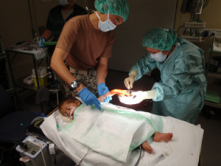SURGICAL SUPPORT FOR AFGHANISTAN
PHOTO // Courtesy of the SAF surgical team
Members of the Singapore Armed Forces' (SAF's) first surgical team to Afghanistan tell us what it is like heading to the conflict zone and being at the front line.
For Captain (CPT) (NS) (Dr) Tan Wah Tze, it was certainly a different experience from his usual In-Camp Training. Instead of serving as a medical officer in the SAF's Combat Support Hospital, the 38-year-old consultant anaesthetist was deployed for two months in the Afghan province of Oruzgan.
He was one of three Operationally Ready National Servicemen (NSmen), together with general trauma surgeon Major (MAJ) (NS) (Dr) Philip Iau and orthopaedic surgeon CPT (NS) (Dr) Mathew Cheng, who volunteered to serve there as part of an eight-man surgical team from the SAF.
From 1 Apr to 30 May, the team provided surgical and medical support to the international coalition troops at a field hospital in a base at Tarin Kowt, the provincial capital of Oruzgan, as well as emergency medical care for the Afghan locals.
This mission was the SAF's 10th deployment to the war-torn country since 2007, and marked the first time NSmen have been sent to Afghanistan.
Answering the call of duty
On his decision to volunteer for the mission, CPT (NS) (Dr) Tan said: "As NSmen, we are part of the operationally-ready force of the SAF and it's an honour to add our experience and skills to the SAF's contribution in Afghanistan's reconstruction and stabilisation efforts."
As for CPT (NS) (Dr) Cheng, he went simply because he was ready and willing: "I'm the type who can rough it out in a rugged environment and I have the suitable skills to do a wide range of surgeries, so I felt that I had a responsibility to go." The 43-year-old former commando medical officer had participated in the SAF's peacekeeping mission to East Timor in 2002.
Despite having made up his mind to go right from the start, CPT (NS) (Dr) Cheng found it tough to be away from his first-born daughter, who was only four months old when he left Singapore.
Noting that it was only natural for families to object and not want their loved ones to go overseas to combat zones, CPT (NS) (Dr) Cheng was thankful for his wife's support, and stayed in regular contact with her via e-mail and satellite phone.
Operating in Afghanistan
Working in a war zone under the austere conditions of a military field hospital was a learning experience for the team as their two-month stint in Afghanistan saw several rocket strikes, with several artillery rounds landing in the surrounding area.
In the event of a warning siren, the team would stay put in protected shelters like the field hospital and housing containers, which were fortified against such attacks, revealed scrub nurse Military Expert (ME) 1 Wong Zheng Wen. They also took additional precautions to minimise their exposure to risks by restricting their movements in open areas.
Team leader Major (MAJ) (Dr) Muhammad Idu - who has experience from overseas deployments to Indonesia under his belt - also said the cases in Afghanistan were quite different from previous humanitarian aid and disaster relief missions he has been on.
Dealing with combat injuries, such as gunshot wounds or shrapnel and blast injuries resulting from improvised explosive devices (IED), was regular fare for the team. While encountering such injuries was a new experience for the team, they took the challenge in their stride.
Touching lives
The surgical team performed 85 operations and over 100 outpatient reviews and consultations, and was proud that no patient died on the operating table during their watch.
Besides the language barrier, another challenge the team faced was coping with limited manpower and equipment. Instead of the usual 10 to 20 personnel deployed in Singapore's civilian operating theatres, they had to multi-task and function as a lean team of about five in Afghanistan.
Commenting that this mission has shown that NSmen and Regulars can deploy and work together effectively, MAJ (Dr) Idu said: "It was a very good composite team... The NSmen doctors adapted pretty well to the military environment, and they are experts in their own areas, so they had a wealth of experience to share with the rest."
For CPT (NS) (Dr) Tan, the success of the mission was due to the hard work and close bonds formed among members of the team, who included scrub nurse ME4 Lim Poh Thiam, anaesthetic nurse ME3 Andy Oh and Intensive Care Unit (ICU) nurse ME5 Ng Geok Cheng.
He said: "During the mission, we didn't distinguish between NSmen and Regulars. We were all in the same team and functioned as one, so what we accomplished was definitely a team effort."
ME5 Ng agreed, noting that it was the support of fellow team members that kept morale high.
Speaking about her key takeaway from this mission, she said: "I've gotten first-hand experience in treating different war injuries and seeing how they are managed, from the Emergency Room to the operating theatre to the ICU." She added: "I train NSmen medics and this is something I can use as a great teaching aid."
Following this medical mission, a 52-man Unmanned Aerial Vehicle task group will be deployed from August to November to provide surveillance and security to the armed forces operating in Oruzgan. In addition, a deployment of institutional trainers will be sent to Afghanistan in September. Working together with the Australian Defence Force, these trainers will conduct artillery training for troops from the Afghan National Security Forces.










